
Arne Emil Jacobsen, Hon. FAIA 11 February 1902 – 24 March 1971) was a Danish architect and furniture designer. He is remembered for his contribution to architectural functionalism and for the worldwide success he enjoyed with simple well-designed chairs.

A chair is a type of seat, typically designed for one person and consisting of one or more legs, a flat seat and a back-rest. They may be made of wood, metal, or synthetic materials, and may be padded or upholstered in various colors and fabrics.
George Hepplewhite was a cabinetmaker. He is regarded as having been one of the "big three" English furniture makers of the 18th century, along with Thomas Sheraton and Thomas Chippendale. There are no pieces of furniture made by Hepplewhite or his firm known to exist but he gave his name to a distinctive style of light, elegant furniture that was fashionable between about 1775 and 1800 and reproductions of his designs continued through the following centuries. One characteristic that is seen in many of his designs is a shield-shaped chair back, where an expansive shield appeared in place of a narrower splat design.
Chairs are known from Ancient Egypt and have been widespread in the Western world from the Greeks and Romans onwards. They were in common use in China from the twelfth century, and were used by the Aztecs. In Sub-Saharan Africa, chairs was not in use before introduced by Europeans.

Shaker furniture is a distinctive style of furniture developed by the United Society of Believers in Christ's Second Appearing, commonly known as Shakers, a religious sect that had guiding principles of simplicity, utility and honesty. Their beliefs were reflected in the well-made furniture of minimalist designs.

A Windsor chair is a chair built with a solid wooden seat into which the chair-back and legs are round-tenoned, or pushed into drilled holes, in contrast to standard chairs. The seats of Windsor chairs were often carved into a shallow dish or saddle shape for comfort. Traditionally, the legs and uprights were usually turned on a pole lathe. The back and sometimes the arm pieces are formed from steam bent pieces of wood.

A Morris chair is an early type of reclining chair. The design was adapted by William Morris's firm, Morris & Company, from a prototype owned by Ephraim Colman in rural Sussex, England. It was first marketed around 1866.
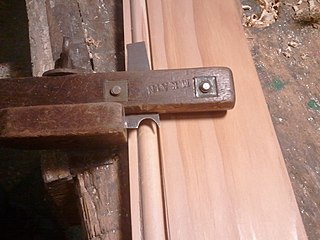
A bead is a woodworking decorative treatment applied to various elements of wooden furniture, boxes and other items.
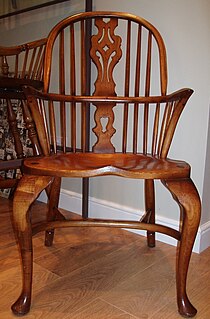
A club foot is a type of rounded foot for a piece of furniture, such as the end of a chair leg. It is also known by the alternative names pad foot and Dutch foot, the latter sometimes corrupted into duck foot.
Ébéniste is a loanword for a cabinet-maker, particularly one who works in ebony.

A cabriole leg is one of (usually) four vertical supports of a piece of furniture shaped in two curves; the upper arc is convex, while lower is concave; the upper curve always bows outward, while the lower curve bows inward; with the axes of the two curves in the same plane. This design was used by the ancient Chinese and Greeks, but emerged in Europe in the very early 18th century, when it was incorporated into the more curvilinear styles produced in France, England and Holland.
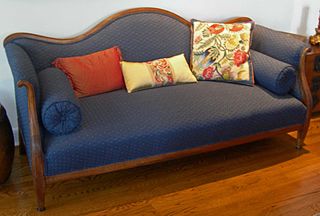
A lyre arm is an element of design in furniture, architecture and the decorative arts, wherein a shape is employed to emulate the geometry of a lyre; the original design of this element is from the Classical Greek period, simply reflecting the stylistic design of the musical instrument. One of the earliest uses extant of the lyre design in the Christian era is a 6th-century AD gravestone with lyre design in double volute form. In a furniture context, the design is often associated with a scrolling effect of the arms of a chair or sofa. The lyre arm design arises in many periods of furniture, including Neoclassical schools and in particular the American Federal Period and the Victorian era. Well known designers who employed this stylistic element include the noted New York City furniture designer Duncan Phyfe.
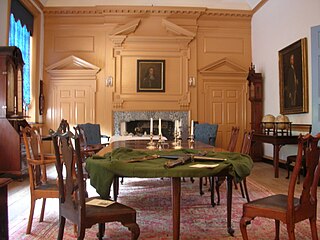
The Queen Anne style of furniture design developed before, during, and after the time of Queen Anne, who reigned from 1702 to 1714.

Thomas J. Duffy is a designer/craftsman whose present work is the conceptualization and creation of curved doors using lasers. Duffy has also crafted one-of-a-kind cabinets, chairs, and other furniture. For many years, Duffy also made St. Lawrence River rowing skiffs. One of his furniture works is in the permanent collection of the Boston Museum of Fine Arts. He has exhibited at numerous galleries and other venues. The New York Times described him as “One of this country’s leading cabinet and chair makers..."

Steam bending is a woodworking technique where wood is exposed to steam to make it pliable. Heat and moisture from steam can soften wood fibres enough so they can be bent and stretched, and when cooled down they will hold their new shape.

Furniture created in the Art Nouveau style was prominent from the beginning of the 1890s to the beginning of the First World War in 1914. It characteristically used forms based on nature, such as vines, flowers and water lilies, and featured curving and undulating lines, sometimes known as the whiplash line, both in the form and the decoration. Other common characteristics were asymmetry and polychromy, achieved by inlaying different colored woods.
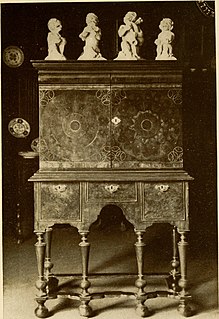
What later came to be known as the William and Mary style is a furniture design common from 1700 to 1725 in the Netherlands, the Kingdom of England, the Kingdom of Scotland, Kingdom of Ireland and later, in England's American colonies. It was a transitional style between Mannerist furniture and Queen Anne furniture. Sturdy, emphasizing both straight lines and curves, and featuring elaborate carving and woodturning, the style was one of the first to imitate Asian design elements such as japanning.
Aspen Golann is an American woodworker who produces furniture.















